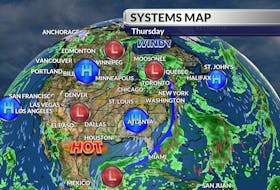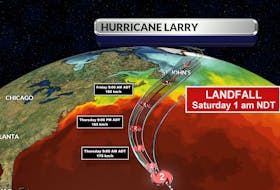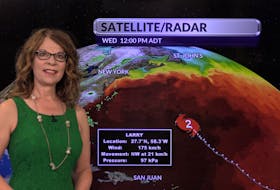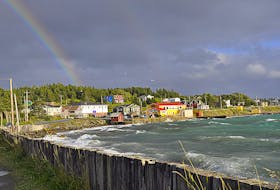As we continue to watch the surreal photos and videos emerge from the Blizzard of 2020 in eastern Newfoundland, people in the Maritimes are asking how this might compare with our powerful nor’easter named White Juan.

Newfoundland Blizzard
Jan. 17, 2020
The Colorado Low responsible for the snow and wind emerged from the northeastern United States early Thursday and underwent explosive cyclogenesis as it tracked southeast of the Avalon Peninsula on Friday. The forward speed on the storm was close to 80 km/h. The storm battered the eastern half of the island with heavy snowfall, extremely high winds and damaging coastal storm surge.
- Highest snow total: 93 cm – Mount Pearl
- Highest wind gust: 171 km/h – Green Island, Fortune Bay
- Maximum sustained wind (estimated): 157 km/h – St John’s Airport
- Lowest central pressure: 954 millibars
- Waves: 10-13 metres

White Juan
Feb. 17, 2004
White Juan is the unofficial name given to the hurricane-strength nor’easter of February 2004 that affected most of Atlantic Canada and the Eastern United States between Feb. 17 and 20.
The storm formed 200 kilometres southeast of Cape Hatteras, N.C. on Feb. 17, 2004. It intensified over the Gulf Stream.
- Highest snow total: 101 cm – Yarmouth
- Highest wind gust: 176 km/h – Halifax Harbour
- Max sustained wind: 151 km/h McNab’s Island
- Lowest central pressure: 959 millibars
- Waves: 10-15 metres
Topography, geography and many other factors come together to mould each and every storm, and like snowflakes, no two are alike. However, these two powerful winter storms were fairly similar. The Newfoundland blizzard was a deeper storm and thankfully a fast-moving one. The fact that the maximum sustained wind was over 154 km/h during the NL blizzard makes it equivalent to a Category 2 hurricane.
In both cases, there were difficult times and hardship, but both blizzards brought out the best in the wonderful people in Atlantic Canada.
- Want more weather information? Visit your weather page.
- Have a weather question, photo or drawing to share with Cindy Day? Email [email protected]
Cindy Day is the chief meteorologist for SaltWire Network









